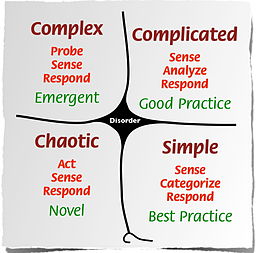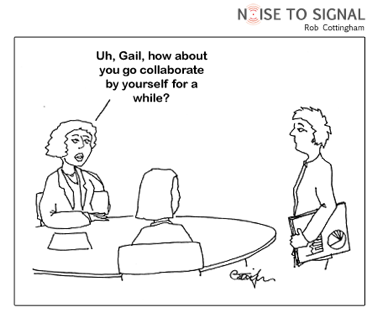Some of us are very passionate about generating collaboration wherever we go in many different contexts because collaboration has not be emphasized as an approach in our business and organizational domains. Other people are less inclined to collaboration because they feel they work better alone or they see collaboration takes a lot of resources and time. Even if you are passionate about working toward solutions together, it’s important to discern when collaboration is most needed and effective as an approach.
The first question to ask is “what kind of problem are we trying to solve”? Different situations require different approaches to understanding the nature of the problem and responding. This has implications on whether or not we need to collaborate as well as how we communicate the solution. In business as well as other organizations, focusing lots of resources (people’s time, energy, skills) to collectively resolve an issue or innovate can be a costly effort, prompting mindful, wise discernment. Sometimes, one or two people with the right information and skillset can handle previously experienced issues or someone needs to step up into leadership to determine the path forward.
The Cynefin (pronounced “cunevin”) Framework, originally created by Dave Snowden, provides an accessible framework for use in those moments when we’re trying to determine the appropriate approach to solving a problem.

There are five elements in this model:
- Simple – This is a problem where the relationship between cause and effect is obvious to all. Our approach is to sense what’s happening, categorize it in relation to known experiences and constraints, and respond accordingly. An example of this in an office environment is when we press print and no copies come out of the printer. We sense that something is not working with the printer, and we start to look into the categories of well-known solutions, such as checking to see if it has paper, checking to see if there is enough toner or even checking to see if we turned it on. When we identify the correct category, it is apparent how we need to respond.
- Complicated – Complicated issues have multiple answers or solutions. Our approach is to access data and other information about possible solutions and perform an analysis to evaluate the best approach before determining response. We move through compromise and into convergence fairly quickly. Continuing our office copier example, if the copier breaks down repeatedly and a technician is called in, they will test all aspects of the copier system to identify what’s occurring. After these discovery efforts, they provide a set of options for the office manager to discuss with others in the business, taking into consideration the company budget, operations strategies, and perhaps conflicting priorities. Given those factors, compromise is reached and the best option selected.
- Complex – This is where real collaboration is most effective. We need everyone’s contribution into a space where someone has identified a problem and brings it to the group. All the questions and ideas that emerge are part of the probing and sensing into the complexity of the issue. Eventually, the group’s work is facilitated into convergence. In our copier example, this may be the situation where the office is growing very quickly which results in a significant increase in the volume and types of copies that are needed on a daily basis. The office copier machine in the break room is no longer sufficient. With new technologies being developed, the office is also not certain if the increased volume and types of copies needed will be sustained over the long term. The team needs to determine the right questions to ask about the growth trends and needs over the longer term and may need to experiment with different options to gain more knowledge of the needs and find the appropriate solution(s).
- Chaotic – This is when a rapid response is needed – the proverbial “hair’s on fire” situation. In this situation, searching for the right answers may waste time, and the group needs to act quickly, gain a sense for what needs to be done and respond. In these circumstances, often a leader will take charge and act because there’s little time for collaboration. For example, a firm might get a last minute giant opportunity that requires duplication beyond what the organization has experienced before and it all needs to be done by the next day. A project leader emerges and rallies prioritization and support for taking immediate action, then orchestrates all aspects of a response. They must negotiate a budget, inspire people to work on the project, select and coordinate with an outside vendor to complete the job, and deliver the final copies to the customer on time. That project leader needs to manage deadlines, engage people’s cooperation, and smooth any barriers in the path so that the project is delivered successfully.
- Disorder – Disorder is the space in the middle signifying you don’t know where you are. From there, you need to find enough information to move yourself into one of the four other spaces. Imagine coming into your business or organization’s office and finding that it has been severely vandalized the previous night. Office machines are wrecked, computers are missing, files are strewn everywhere, and people’s workspaces have been turned upside down. Everyone is in a state of shock. Work obviously has come to a standstill.
Understanding the type of problem sets the need for collaboration, and if needed, the tone of collaboration. A shared framework like the one we’ve outlined above can provide the basis for a team’s agreements and approaches to taking action.
How would you apply the Cynefin Framework in your work and workplace? What scenarios come to mind for each of the problem types?

 personal and professional abilities, personalities and experience of participants are the elements being combined. The
personal and professional abilities, personalities and experience of participants are the elements being combined. The 
 As we analyzed participants’ responses, we recognized a pattern in what they had communicated. Achieving even basic collaboration requires an essential mix of certain personal capacities, group values, and environmental attributes. Understanding that these are the basic ingredients helps us to make sure we are gathering the people, developing the culture and structuring the environment that successfully establishes this “zone of collaboration.”
As we analyzed participants’ responses, we recognized a pattern in what they had communicated. Achieving even basic collaboration requires an essential mix of certain personal capacities, group values, and environmental attributes. Understanding that these are the basic ingredients helps us to make sure we are gathering the people, developing the culture and structuring the environment that successfully establishes this “zone of collaboration.” How are organizations beginning to think about reorganizing work to foster more creative freedom and collaboration? Some of the first things to consider are organizing around shared purpose and values, clarifying roles and authority, and building trust and accountability. Some approaches use structures such as stakeholder engagement models, consensus decision-making, and systems for increasing transparency and decentralizing power. Because there’s a lot at stake in business, organizations wanting change seek models that combine rigor with creative autonomy. And, let’s admit it, we modern humans have kind of lost the knack for creating workplaces that are freedom-focused instead of fear-based, so we’ve got some relearning to do.
How are organizations beginning to think about reorganizing work to foster more creative freedom and collaboration? Some of the first things to consider are organizing around shared purpose and values, clarifying roles and authority, and building trust and accountability. Some approaches use structures such as stakeholder engagement models, consensus decision-making, and systems for increasing transparency and decentralizing power. Because there’s a lot at stake in business, organizations wanting change seek models that combine rigor with creative autonomy. And, let’s admit it, we modern humans have kind of lost the knack for creating workplaces that are freedom-focused instead of fear-based, so we’ve got some relearning to do.  Rani: You recently participated in a two-day immersion into the Holacracy method. Would you be willing to share why you were attracted to this training?
Rani: You recently participated in a two-day immersion into the Holacracy method. Would you be willing to share why you were attracted to this training? 
 an society during which we need to re-imagine and co-create a new economy and the path to a flourishing world. As we continue our exploration of critical thinking in business, we found ourselves caught up in a tangle of questions about Ideas in the context of Third Wave Business. We thought we’d share what we notice as we sort out the threads.
an society during which we need to re-imagine and co-create a new economy and the path to a flourishing world. As we continue our exploration of critical thinking in business, we found ourselves caught up in a tangle of questions about Ideas in the context of Third Wave Business. We thought we’d share what we notice as we sort out the threads. novative, open and generous attracts opportunities, collaborations and support. Building thriving relationships becomes the foundation for our personal success in the larger field of business and community.
novative, open and generous attracts opportunities, collaborations and support. Building thriving relationships becomes the foundation for our personal success in the larger field of business and community.


 ss to me means that I am the absolute owner of my time here on this planet, that there are opportunities for me to continually grow, to contribute to the history and the workings of the world that are positively impactful, to regenerate the commons and allow me to sustain myself, my family and my community. As a student of the Integral MBA for Creative Enterprise, we are building our capacities in transformative innovation and regenerative entrepreneurship with the intent of regenerating the commons or all shared resources, social and environmental. We are at the forefront of becoming leader-practitioners that are well equipped with next practices to navigate the unknownness of the world’s future, particularly in business, in order to make those incremental shifts towards the disruptive systemic change that is desperately needed for the 21st century.”
ss to me means that I am the absolute owner of my time here on this planet, that there are opportunities for me to continually grow, to contribute to the history and the workings of the world that are positively impactful, to regenerate the commons and allow me to sustain myself, my family and my community. As a student of the Integral MBA for Creative Enterprise, we are building our capacities in transformative innovation and regenerative entrepreneurship with the intent of regenerating the commons or all shared resources, social and environmental. We are at the forefront of becoming leader-practitioners that are well equipped with next practices to navigate the unknownness of the world’s future, particularly in business, in order to make those incremental shifts towards the disruptive systemic change that is desperately needed for the 21st century.”

